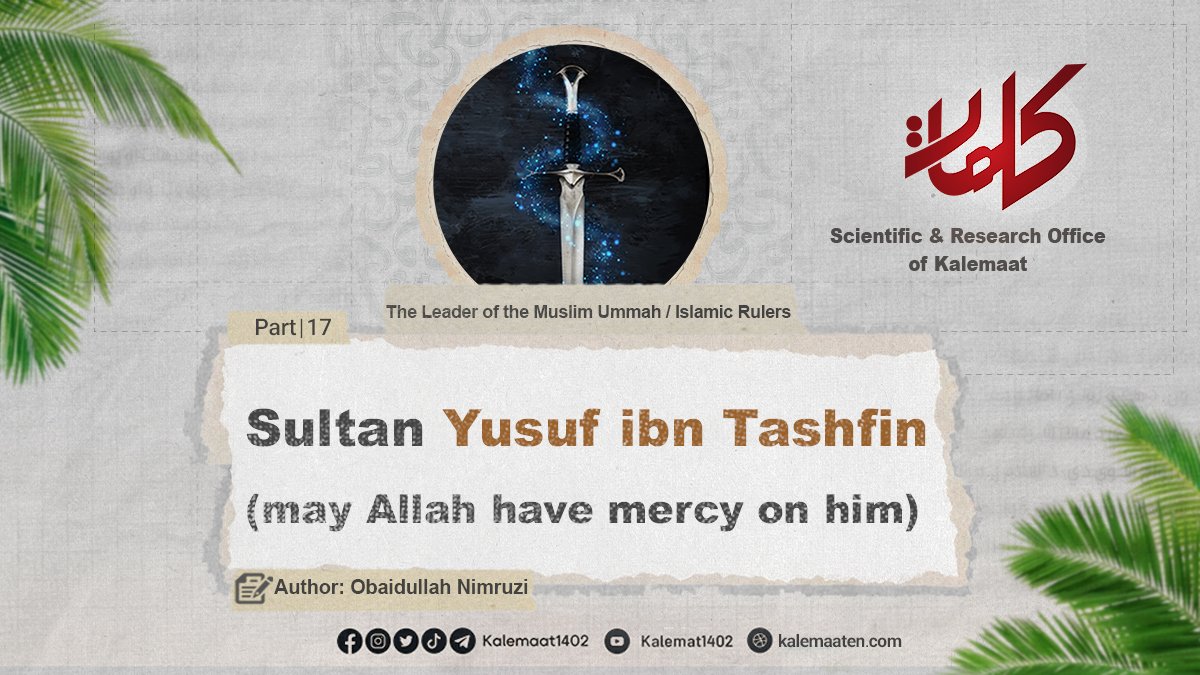
Author: Obaidullah Nimruzi
The Guardian of Al-Andalus (Spain): Sultan Yusuf ibn Tashfin [MABH] (Part 17)
Abu Bakr ibn Umar’s return to the desert and its reasons
Abu Bakr ibn Umar, one of the great leaders of the Al-Murabitin movement, made an important and strategic decision and entrusted the command of the northern part of the Al-Murabitin army to his cousin, Yusuf ibn Tashfin, while he himself assumed command of the other part of the army for the movement to the south. This division of the army into two independent parts was made in response to the new political and military conditions of the time; conditions that required an army to be stationed in the Great Desert, the original birthplace of the Al-Murabitin, to take on the task of establishing security, correcting internal disputes, and consolidating the foundations of the Islamic call.
This region was not only the original homeland of the Al-Murabitin; but also a powerful supporter of their forces; therefore, an army had to be present there to both continue the spread of the call to Islam to the south, where polytheism, idolatry, and armed tribes were a constant threat to the desert, and to keep the rear of the northern army safe. In fact, Abu Bakr ibn Umar’s successes in the south allowed the northern army, led by Yusuf ibn Tashfin, to focus on its extensive missions, confident in the stability of the southern front.
But choosing Yusuf ibn Tashfin for this dangerous mission was not an easy task. The northern region of the Maghreb presented many obstacles and challenges: impassable mountains, tribes with a stubborn disposition, fortified fortresses and castles, as well as emirates with regular military structures that could be militarily on a par with the newly established al-Murabitin army. If the spirit of jihad, complete readiness for martyrdom, and strict adherence to the principles of the Al-Murabitin call based on justice, equality, and Islamic brotherhood did not exist among the Al-Murabitin, Yusuf ibn Tashfin would never have been able to carry out these dangerous tasks and implement his ambitious plans.
Abu Bakr ibn Umar made this choice after many tests, based on a deep understanding of Yusuf’s military and managerial abilities. Characteristics such as asceticism, piety, simplicity, disregard for the world, and steadfastness in the path of Islamic calling were among the most important factors in this choice. He even asked Allah for good in this regard, prayed, and made Istikharah to choose a worthy and righteous person for the caliphate.[1]
Incidentally the elites and people of opinion among the Al-Murabitin also agreed on the choice of Yusuf ibn Tashfin, because they believed in his religiosity, courage, tact, justice, and military and moral abilities.[2]
Understanding the greatness of the responsibility and confident in the correct choice, Abu Bakr ibn Umar completed his mission in the north and returned to the desert. By this transfer, Yusuf ibn Tashfin’s star began to shine in the western sky. He was able to defeat the enemies who intended to take advantage of the absence of Abu Bakr ibn Umar by utilizing his military intelligence, courage, and leadership power. Yusuf ibn Tashfin, adopting a policy of concentrating all forces for victory, attacked the enemies in all directions, because he rightly believed that “attack is the best method of defense”.
The result of this policy was the fall of many fortresses and the establishment of the Al-Murabitin in most of the Far West. The Al-Murabitin army also gained a lot of experience in these battles and gained a strength that could operate effectively on all fronts under the command of Yusuf ibn Tashfin.
The return of Abu Bakr ibn Umar from the Sahara: historical fact or myth?
After a series of victories that the armies of Yusuf ibn Tashfin achieved in the north of the West, Emir Abu Bakr ibn Umar also completed his missions in the Sahara. He managed to quell seditions, calm tribal conflicts, and establish a force in the south whose task was to defend the southern borders of the state and also to call for Islam and jihad in the regions of western Sudan. As the situation in those areas calmed down, he decided to return to the West to inform about the state of the government and the conditions of the subjects and governors in the north. This return took place around 465 AH.[3]
Conflicting accounts of the meeting between the two great commanders
The return of Abu Bakr ibn Umar to the Maghreb is not free from historical debate and controversy. Some sources, such as “Rawzat al-Qirtas: 86 and al-Bayan al-Maghrib by Ibn al-Azaari, vol. 4, p. 23,” claim that this meeting was accompanied by some hidden political tension, and some accounts even state that Abu Bakr ibn Umar intended to take control of affairs again and remove Yusuf ibn Tashfin from power. Following this possibility, Yusuf consulted his wife, Zainab al-Nafzawiyyah.
Zainab al-Nafzawiyyah; Between historical reality and literary fiction
In these accounts, Zainab al-Nafzawiyyah is depicted as an influential woman in government affairs; as they say, she drew up a plan to deal with Abu Bakr: Yusuf first confronted him with arrogance and coldness; then, he won his heart by gifts, wealth, and a change of clothes, and established his kingdom. [4] But this image does not seem to be consistent with the historical reality and the spirit of the two mujahid and ascetic commanders.
Two veteran companions on the same path
The truth is that both of them, namely Yusuf bin Tashfin and Abu Bakr bin Umar, were loyal disciples of Sheikh Abdullah bin Yasin, may Allah bless him; a man who had called them to asceticism, sincerity, abandoning greed for the throne and avoiding jealousy and futile competition. This upbringing caused Yusuf to greet Abu Bakr with humility and respect when they met, and Abu Bakr, seeing Yusuf’s good judgment and competence, voluntarily entrusted him with the administration of the northern regions.[5]
Legend or politics?
Therefore, it is clear that the stories that show Zaynab Nafzawiyya as the ruler behind the scenes are more like entertaining legends than reports based on accurate historical analysis. These mythologies may have been created with the intention of inciting the emotions of the audience or even to undermine the character of Yusuf ibn Tashfin and his loyalty to the ideals of the Al-Murabitin call.
Zainab Nafzawiyyah; Rereading a female character in the social context of her time
However, the role of Zainab Nafzawiyyah should not be ignored, but it is necessary to reread it with a fair and realistic perspective. In “Rawzat al-Qirtas” p. 84, she is introduced as Zainab, daughter of Ishaq al-Hawari, from a merchant family from Kairouan. This woman, who was known as the Saherah (witch) because of her beauty and intelligence, was undoubtedly an intelligent and capable woman, but her presence in the politics of the Al-Murabitin state – if really happened – was more in the form of intelligent social participation, rather than dominance and tyranny in government affairs.
The Secret of Zainab Nafzawiyyah in the Narration of ibn Khaldun and Other Historians
In the narration of Ibn Khaldun, Zainab, the daughter of Ishaq Nafzawiyyah, is introduced as one of the famous women of her time, known for her beauty and leadership.[6] When Abu Bakr ibn Umar captured the city of Aghmat, he married Zainab after the killing of her husband, Luqout ibn Yusuf al-Mughrawi. Before marrying Luqout, she was the wife of Yusuf ibn Abd al-Rahman ibn Watas, the chief of the Warika tribe in the Aghmat region; then, after Abu Bakr ibn Umar returned to the southern desert to carry out his mission, Zainab married Yusuf ibn Tashfin, according to his will.
Women of the Al-Murabitin Court: Beyond Zainab
Besides Zainab, Yusuf ibn Tashfin had other wives, all of whom had a prominent position and beauty in Al-Murabitin society. Among them was “Qamar”, the mother of Ali, who succeeded his father as Emir of the Muslims and was known as “Umm al-Hasan” or “Faz al-Hasan”. Also “Aisha” was another of Yusuf’s wives, who became the mother of a brave and skilled commander who achieved remarkable victories in Andalusia.
Myth or reality? Zainab’s influence in the Al-Murabitin court
If Zainab had as much influence over Yusuf as some sources claim, she should have been able to make her son Tamim the heir apparent; while Ali, Qamar’s son, became the heir apparent despite being younger than Tamim. Furthermore, if Zainab had such extensive influence, she could have achieved her goals by various means; especially if the narratives consider her to be an intelligent woman and skilled in state affairs; But the choice of Ali as successor, the short period of Zaynab’s marriage to Yusuf before his death, and the history of her previous marriages all suggest that the narrative of her dominance, even if popular, is not based on solid foundations.
Continues…
References:
- Ibn Azaari, Al-Bayan Al-Maghrib, vol. 4, p. 20.
- Ibn Abi Zar’, Rawzat Al-Qirtas, p. 72.
- Al-Qalsadi, Al-Hilal Al-Moshiyah, p. 64.
- Al-Salawi, Al-Istiqsā, p. 23.
- Al-Bayan Al-Maghrib, vol. 23/2; Ahmad Al-Ala’am Ibn Al-Khatib, vol. 3, p. 232; Al-Ibar Ibn Khaldun, vol. 6, p. 184.
- Al-Salawi, Al-Istiqsā, p. 15.



